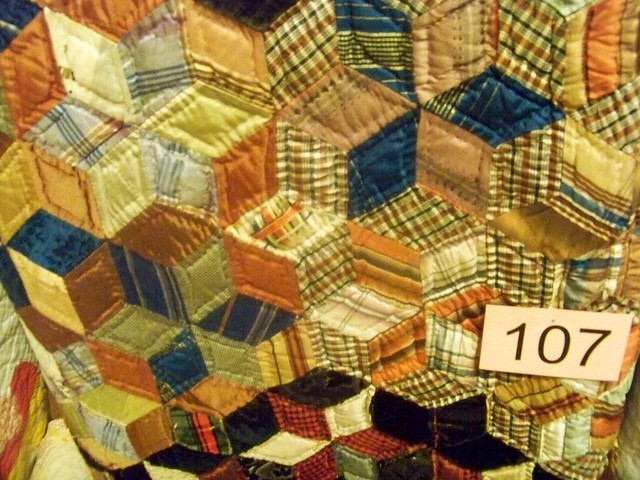Two unique quilts in this year’s “A Stitch in Time” quilt show, open now through May 31, 2012, serve to connect the start of our nation’s great experiment in democracy with the infamous terrorist attack we refer to as 9-11.

Quilting has long been a part of American history
HISTORY:
Mount Vernon home, a frugal stitcher snipped and pieced parts of one of her elegant petticoats into a quilt that takes us back to Colonial times.
PATRIOTISM:
Jump ahead more than 200 years, from our nation’s most hopeful era to its most painful day, and stitcher and patriot Robert Mullins confronts us with a poignant reminder of the tragedy that forever changed America’s mindset about safety within its shores. Mullins, incorporating more than 20 yards of fabric into his project, has machine embroidered on his quilt the names of the 2,914 people who died in the terrorist attack launched on Sept. 11, 2001.

Quilt in honor of all of those who lost their lives in the Sept. 11, 2001 attacks
Through the museum’s display of 117 quilts, we see how these and other examples of this creative art form pull together our cultural legacy as effectively as any written text or oral history. From a 1940s feed sack quilt to a 21st Century t-shirt quilt, stitchers share their creativity and love for preserving special family memories. Three Bible quilts tell revered stories through embroidered pictorial blocks, and a President’s quilt takes viewers from George Washington’s era to that of George W. Bush.
Traditional Victorian Crazy Quilts, with their lavishly embellished rich velvet and satin fabrics, contrast with well-worn utilitarian quilts made from scraps of coats and clothing of bygone days. Modern stylized quilts reflect today’s more prosperous households, where quilting is now a cherished hobby, instead of a routine necessity.

Quilts of all types are on display at the "Stitch in Time" Quilt Show at Southwest VA Museum
QUILTS OF COMFORT:
The exhibit’s accompanying guide booklet contains the pattern names and information about the history and origin of each, including the number of hours invested and the names of those who did the piecing and quilting, if known. Their mini-stories provide a rich array of details that enrich the experience of all who come to see the show.
From the Great Crusades forward, and some historians say back to Egyptian times, quilts have offered comfort, protection and warmth to those who use them. The earliest quilting techniques were used to create padding for restrictive body armor and many years later, ornate works of fabric art for the wealthy to enjoy. It took several hundred years for the practice of layering fabric and padding, or filler material, to gradually evolve into quilts that added an extra layer of warmth to winter-chilled households.
Ironically, it was the production of the first affordable home sewing machines, offered on an “easy payment plan” by the Singer Company in 1856, that opened the doors to quilting for average households. With the new Singers, quilt tops could be machine-pieced, shortening the time needed to finish up by adding the backing and filler, which were hand-stitched or “tacked” to bind the layers together.
This method of quilting rapidly gained momentum in the Civil War era, as a wide range of shortages gave new emphasis to frugality in every facet of homemaking, and families realized that their “scrap” quilts offered a way to provide much-needed warmth and even a touch of home to those on the battle lines.
Large and small, old and new, quilts bind together the arts of storytelling, frugality and creativity.
SHOW HOURS AND FEES:
Come see the show at The Southwest Virginia Museum Historical State Park soon. Hours are: Tuesday through Thursday from 10 a.m. to 4 p.m.; Fridays, 9 a.m. to 4 p.m.; Saturdays, 10 a.m. to 5 p.m. and Sundays, 1 p.m. to 5 p.m. The museum is closed Mondays until after Memorial Day. Admission is $4 for adults, $2 for children ages 6-12 and children under 6 are admitted free.
DIRECTIONS AND MORE INFO:
For location information and additional program and festival listings, visit the museum’s official state parkwebsite.
